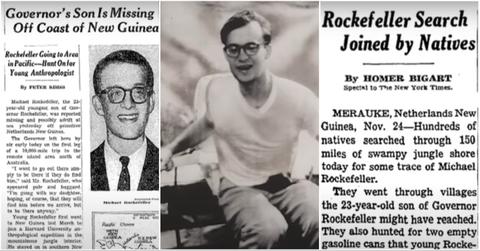What Happened to Michael Rockefeller? A Lost Heir’s Mystery Still Grips History Buffs
Michael Rockefeller disappeared on Nov. 19, 1961, his body was never recovered.
Published May 30 2025, 12:24 p.m. ET
You don’t have to be a history buff to get caught up in a good mystery. Some stories just stick — not because we know how they end, but because we don’t. That’s exactly the case with Michael Rockefeller.
His name still hangs on the walls of a museum wing dedicated to the very art he traveled halfway around the world to collect. As of May 2025, visitors could walk through the Michael C. Rockefeller Wing at the Metropolitan Museum of Art and see towering ancestor poles and ceremonial carvings from New Guinea.
The art, however, isn’t the only thing that keeps people coming back — it’s the mystery of Michael himself. What happened to Michael Rockefeller, exactly?

Michael Rockefeller's father hosts a press conference.
What happened to Michael Rockefeller continues to fascinate because no one truly knows.
In 1961, 23-year-old Michael Rockefeller vanished off the coast of what was then Dutch New Guinea. Per Town and Country Mag, he and an anthropologist companion were traveling by catamaran when the boat capsized miles from shore. After clinging to the wreckage for nearly a day, Michael decided to swim to land. “I think I can make it,” he said, before pushing off into the water. That was the last time anyone saw him.
A massive search followed — ships, planes, helicopters, even Dutch and American authorities all joined in. Unfortunately, the search came up empty. No body, no belongings, and no clues. In 1964, a judge declared him dead by drowning. But that was just the beginning of the theories.
Over the years, people have guessed everything from a shark attack to voluntary exile in the jungle. The most chilling theory? That Michael was killed — and possibly eaten — by members of the Asmat tribe he had come to admire.
Michael came to collect art but got caught in something deeper.
Michael wasn’t a thrill-seeker or a trophy hunter. He was a recent Harvard graduate with a love of art and history, especially the ceremonial carvings of the Asmat people. His father, then–New York Governor Nelson Rockefeller, had opened a Museum of Primitive Art. Michael wanted to help build its collection, not from auctions or dealers, but directly from the source.
Per How Stuff Works, he traded for carved poles, shields, drums — hundreds of pieces — offering tools, tobacco, and other supplies in return. According to many who knew him, he wasn’t arrogant or careless. He was curious, respectful, and deeply interested in the culture. But that didn’t mean he understood everything.
Journalist Carl Hoffman spent years investigating Michael’s disappearance for his book Savage Harvest: A Tale of Cannibals, Colonialism, and Michael Rockefeller's Tragic Quest for Primitive Art. What he uncovered was disturbing. In the years just before Michael arrived, Dutch authorities had raided villages in the region, killing several prominent Asmat men. Some villagers believed those deaths needed to be avenged.
According to Carl’s research, Michael may have made it to shore, but arrived alone, exhausted, and vulnerable. In that moment, he stopped being just a visitor. He became, to some, a symbol of colonial power. Whether what followed was revenge, ritual, or both, Carl believes that Michael was killed as part of a sacred act of balance, not out of hatred, but meaning.
The Rockefeller Wing still holds the art he collected — and the silence he left behind.
On May 31, 2025, the Rockefeller Wing was set to reopen. Those who walk through it have the opportunity to see the bisj poles Michael once described in his letters. They were more than decoration. They were part of a ritual that honored the dead and called for justice. “The figures represented people who have been headhunted and will be avenged,” he once wrote, per Town and Country Mag.
As of 2025, no one is really sure what happened to Michael. The mystery behind his disappearance and assumed death, however, is largely what makes his story so interesting.
